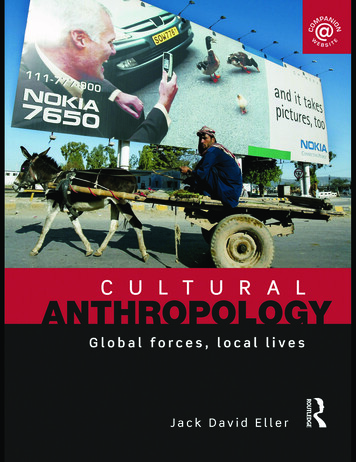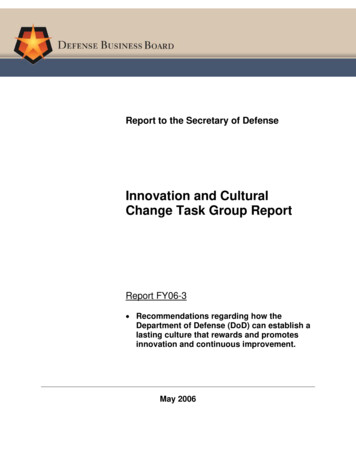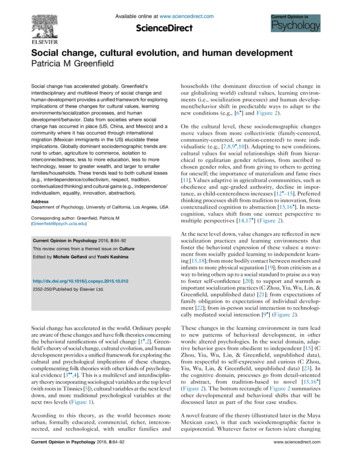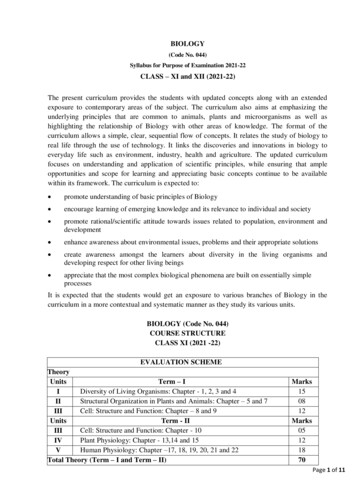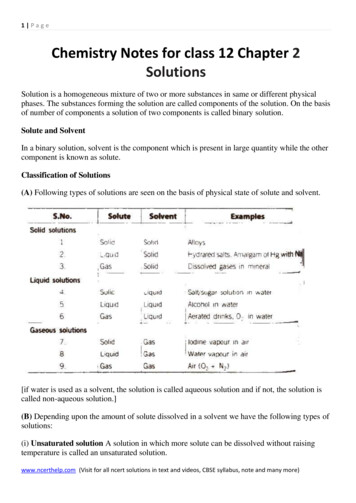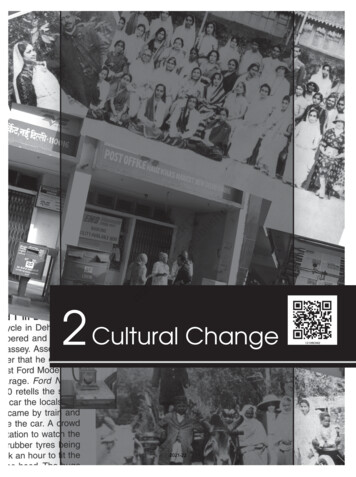
Transcription
2 Cultural Change2021-222021-22
Social Change and Development in IndiaW e saw in the last chapter how colonialism brought in changes that alteredthe structure of Indian society. Industrialisation and urbanisation transformedthe lives of people. Factories replaced fields as places of work for some. Citiesreplaced villages as places to live for many. Living and working arrangementsor structures changed. Changes also took place in culture, ways of life, norms,values, fashions and even body language. Sociologists understand, socialstructure, as a ‘continuing arrangement of persons in relationships defined orcontrolled by institutions’ and ‘culture’ as ‘socially established norms or patternsof behaviour’. You have already studied about the structural changes thatcolonialism brought about in chapter 1. You will observe how important thosestructural changes are for understanding the cultural changes that this chapterseeks to understand.This chapter looks at two related developments, both a complex product ofthe impact of colonial rule. The first deals with the deliberate and consciousefforts made by the 19th century social reformers and early 20th centurynationalists to bring in changes in social practices that discriminated againstwomen and ‘lower’ castes. The second with the less deliberate yet decisive changesin cultural practices that can broadly be understood as the four processes ofsanskritisation, moder nisation, secularisation and wester nisation.Sanskritisation pre-dates the coming of colonial rule. The other three processescan be understood better as complex responses of the people of India to thechanges that colonialism brought about.2.1 SOCIAL REFORM MOVEMENTS IN THE19TH AND EARLY 20TH CENTURYYou have already seen the farreaching impact of colonialismon our lives. The social reformmovements which emerged inIndia in the 19th century arose tothe challenges that colonialIndian society faced. Youprobably are familiar with whatwere termed social evils thatplagued Indian society. The wellRaja Ram Mohun RoyPandita RamabaiSir Syed Ahmed Khanknown issues are that of sati,child marriage, ban on widow remarriage and caste discrimination. It is not thatattempts were not made to fight social discrimination in pre-colonial India. Theywere central to Buddhism, to Bhakti and Sufi movements. What marked theseth19century social reform attempts was the modern context and mix of ideas. It18was a creative combination of modern ideas of western liberalism and a new lookon traditional literature.2021-222021-22
Cultural ChangeBOX 2.1The mix of ideasØØØØØRaja Ram Mohun Roy attacked the practice of sati on the basis of both appeals to humanitarianand natural rights doctrines as well as Hindu shastras.Ranade’s writings entitled The Texts of the Hindu Law on the Lawfulness of the Remarriage of Widows andVedic Authorities for Widow Marriage elaborated the shastric sanction for remarriage of widows.The content of new education was modernising and liberal. The literary content of the courses in the humanitiesand social sciences was drawn from the literature of the European Renaissance, Reformation andEnlightenment. Its themes were humanistic, secular and liberal.Sir Sayed Ahmed Khan’s interpretation of Islam emphasised the validity of free enquiry (ijtihad) and the allegedsimilarities between Koranic revelations and the laws of nature discovered by modern science.Kandukiri Viresalingam’s The Sources of Knowledge reflected his familiarity with navya-nyaya logic. At thesame time he translated the works of Julius Huxley, an eminent biologist.Sociologist Satish Saberwal elaborates upon the modern context by sketchingthree aspects to the modern framework of change in colonial India:nmodes of communicationnforms of organisation, andnthe nature of ideasNew technologies speeded up various forms of communication. The printingpress, telegraph, and later the microphone, movement of people and goodsthrough steamship and railways helped quick movement of new ideas. WithinIndia, social reformers from Punjab and Bengal exchanged ideas with reformersfrom Madras and Maharashtra. Keshav Chandra Sen of Bengal visited Madrasin 1864. Pandita Ramabai travelled to different corners of the country. Some ofthem went to other countries. Christian missionaries reached remote cornersof present day Nagaland, Mizoram and Meghalaya.New technologies andorganisations that speeded upvarious forms of communication192021-222021-22
Social Change and Development in IndiaViresalingamVidyasagarJotiba Phule20Modern social organisations like the Brahmo Samaj in Bengal andArya Samaj in Punjab were set up. The All-India Muslim LadiesConference (Anjuman-E-Khawatn-E-Islam) was founded in 1914. Indianreformers debated not just in public meetings but through public medialike newspapers and journals. Translations of writings of social reformersfrom one Indian language to another took place. For instance, VishnuShastri published a Marathi translation of Vidyasagar’s book in InduPrakash in 1868.New ideas of liberalism and freedom, new ideas of homemaking andmarriage, new roles for mothers and daughters, new ideas of selfconscious pride in culture and tradition emerged. The value of educationbecame very important. It was seen as very crucial for a nation to becomemodern but also retain its ancient heritage. The idea of female educationwas debated intensely. Significantly, it was the social reformer JotibaPhule who opened the first school for women in Pune. Reformers arguedthat for a society to progress women have to be educated. Some of thembelieved that in pre-modern India, women were educated. Otherscontested this on the grounds that this was so only of a privileged few.Thus attempts to justify female education were made by recourse toboth modern and traditional ideas. They actively debated the meaningsof tradition and modernity. Jotiba Phule thus recalled the glory of preAryan age while others like Bal Gangadhar Tilak emphasised the gloryof the Aryan period. In other words 19th century reform initiated a periodof questioning, reinterpretations and both intellectual and social growth.The varied social reform movements did have common themes. Yetthere were also significant differences. For some the concerns wereconfined to the problems that the upper caste, middle class women andmen faced. For others the injustices suffered by the discriminated castes werecentral questions. For some social evils had emerged because of a decline of the2021-222021-22
Cultural Changetrue spirit of Hinduism. For others caste and gender oppression was intrinsicto the religion. Likewise Muslim social reformers actively debated the meaningof polygamy and purdah. For example, a resolution against the evils of polygamywas proposed by Jahanara Shah Nawas at the All India Muslim LadiesConference. She argued: the kind of polygamy which is practiced by certain sections ofthe Muslims is against the true spirit of the Quran and it is theduty of the educated women to exercise their influence amongthe relations to put an end to this practice.The resolution condemning polygamy causedconsiderable debate in the Muslim press. Tahsib-eNiswan, the leading journal for women in the Punjab,came out in favour of the resolve, but others disapproved.(Chaudhuri 1993: 111). Debates within communitieswere common during this period. For instance, sati wasopposed by the Brahmo Samaj. Orthodox members ofthe Hindu community in Bengal formed an organisationcalled Dharma Sabha and petitioned the British arguingthat reformers had no right to interpret sacred texts.Yet another view increasingly voiced by Dalits was acomplete rejection of the Hindu fold. For instance, usingthe tools of modern education, Muktabai, a 13 year oldstudent in Phule’s school writes in 1852:ACTIVITY 2.1Find out about some of the socialreformers mentioned below? Whatissues did they fight for? How didthey conduct their campaign? Wasthere any opposition?ØØØØØØØØLet that religionWhere only one person is privilegedAnd the rest are deprivedPerish from this earthAnd let it never enter our mindsTo be proud of such a religion ViresalingamPandita RamabaiVidyasagarDayanand SaraswatiJyotiba PhuleSri Narayan GuruSir Sayed Ahmed KhanAny other2.2 HOW DO WE APPROACH THE STUDY OFSANSKRITISATION, MODERNISATION,SECULARISATION AND WESTERNISATIONIn this chapter each of the four concepts, namely sanskritisation, modernisation,secularisation and westernisation, are dealt with in different sections. But asthe discussion unfolds, it will become obvious to you that in many ways theyoverlap and in many situations they co-exist. In many situations they operatevery differently. It is not surprising to find the same person being modern insome ways and traditional in another. This co-existence is often seen as naturalto India and many other non-western countries.2021-222021-2221
Social Change and Development in IndiaACTIVITY 2.2While you read the way the four processesare used in sociology, it may be interesting todiscuss in class what you think the termsmean.Ø What kind of behaviour would you define as:WesternModernSecularSanskritisedØ Why?Ø Return to Activity 2.2 after you finish thechapter.Ø Did you find any difference betweencommon sense usage of the terms andtheir sociological meaning?But you know that sociology does not restcontent with naturalist explanation. (Recall thediscussion in Chapter 1, Class XI book - IntroducingSociology. As the last chapter has shown colonialmodernity had its own paradoxes. Take the exampleof western education. Colonialism led to the growthof an English educated Indian middle class. Theyread the thinkers of western enlightenment,philosophers of liberal democracy and dreamt ofushering in a liberal and progressive India. And yet,humiliated by colonial rule they asserted their pridein traditional learning and scholarship. You havealready seen this trend in the 19th century reformmovements.As this chapter will show, modernity spelled notmerely new ideas but also rethinking andreinterpretation of tradition. Both culture andtradition are living entities. People learn them andin turn modify them. Take the everyday example ofhow the sari or jain sem or sarong is worn in Indiatoday. Traditionally the sari, a loose unstitched pieceof cloth was differently worn in different regions. The standard way that themodern middle class woman wears it was a novel combination of the traditionalsari with the western ‘petticoat’ and ‘blouse’.ACTIVITY 2.3ØThink of other instances of the mix andmatch both from everyday life and fromthe wider level.My father’s clothes represented hisinner life very well. He was a southIndian Brahmin gentleman. He woreneat white turbans, a Sri Vaisnavacaste mark .yet wore Tootal ties,Kromentz buttons and collar studs,and donned English serge jackets overhis muslin dhotis which he woredraped in traditional Brahmin style.The mixand matchof thetraditionaland modern22Source: A.K. Ramanujan in Marriot ed.1990: 422021-222021-22
Cultural ChangeIndia’s structural and cultural diversity is self-evident. This diversity shapesthe different ways that modernisation or westernisation, sanskritisation orsecularisation effects or does not effect different groups of people. The followingpages seek to capture these differences. The constraint of space prevents afurther detailing out. It is up to you to explore and identify the complex waysmodernisation impacts people in different parts of the country or impactsdifferent classes and castes in the same region. And even women and men fromthe same class or community.We begin with the concept sanskritisation. The reason for doing so is becauseit refers to a process that pertains to social mobility that existed before theonset of colonialism. And persisted in diverse ways subsequently. The otherthree changes as we shall shortly see, arose in a context marked by changesthat colonialism brought about. This included direct exposure to modern westernideas of freedom and rights. As mentioned earlier this exposure heightened thesense of injustice on the one hand and humiliation on the other. Often this ledto a desire to go back to one’s traditional past and heritage. It is within this mixthat we can understand India’s tryst with modernisation, westernisation andsecularisation.2.3 DIFFERENT KINDS OF SOCIAL CHANGESANSKRITISATIONThe term sanskritisation was coined by M.N. Srinivas. It may be briefly definedas the process by which a ‘low’ caste or tribe or other group takes over thecustoms, ritual, beliefs, ideology and style of life of a high and, in particular, a‘twice-born (dwija) caste’.The impact of Sanskritisation is many-sided. Its influence can be seen inlanguage, literature, ideology, music, dance, drama, style of life and ritual.It is primarily a process that takes place within the Hindu space thoughSrinivas argued that it was visible even in sects and religious groups outsideHinduism. Studies of different areas, however, show that it operated differentlyin different parts of the country. In those areas where a highly Sanskritisedcaste was dominant, the culture of the entire region underwent a certainamount of Sanskritisation. In regions where the non-Sanskritic castes weredominant, it was their influence that was stronger. This can be termed theprocess of ‘de-Sanskritisation’. There were other regional variations too. InPunjab culturally Sanskritic influence was never very strong. For manycenturies until the third quarter of the 19th century the Persian influence wasthe dominant one.Srinivas argued that, “the Sanskritisation of a group has usually the effectof improving its position in the local caste hierarchy. It normally presupposes2021-222021-2223
Social Change and Development in IndiaKumudtai’s journey into Sanskritbegan with great interest and eagernesswith Gokhale Guruji, her teacher atschool At the University, the Head ofthe Department was a well-knownscholar and he took great pleasure intaunting Kumudtai Despite theadverse comments she successfullycompleted her Masters in Sanskrit .either an improvement in the economic or political positionof the group concerned or a higher group selfconsciousness resulting from its contact with a sourceof the ‘Great Tradition’ of Hinduism such as a pilgrimcentre or a monastery or a proselytising sect.” But in ahighly unequal society such as India there were andstill are obstacles to any easy taking over of the customsof the higher castes by the lower. Indeed, traditionally,the dominant caste punished those low castes, whichwere audacious enough to attempt it. The story belowcaptures the problem.Source: Kumud Pawade (1938)Kumud Pawade in her autobiography recounts howa Dalit woman became a Sanskrit teacher. As a studentshe is drawn towards the study of Sanskrit, perhapsbecause it is the means through which she can break into a field that was notpossible for her to enter on grounds of gender and caste. Perhaps she wasdrawn towards it because it would enable her to read in the original what thetexts have to say about women and the Dalits. As she proceeds with her studies,she meets with varied reactions ranging from surprise to hostility, from guardedacceptance to brutal rejection. As she says:The result is that although I try to forget my caste, it is impossible to forget. And then Iremember an expression I heard somewhere: “What comes by birth, but can’t be cast offby dying - that is caste.”Sanskritisation suggests a process whereby people want to improve their statusthrough adoption of names and customs of culturally high-placed groups. The‘reference model’ is usually financially better of. In both, the aspiration or desire tobe like the higher placed group occurs only when people become wealthier.Sanskritisation as a concept has been criticised at different levels. One, it hasbeen criticised for exaggerating social mobility or the scope of ‘lower castes’ tomove up the social ladder. For it leads to no structural change but only positionalchange of some individuals. In other words inequality continues to persist thoughsome individuals may be able to improve their positions within the unequalstructure. Two, it has been pointed out that the ideology of sanskritisation acceptsthe ways of the ‘upper caste’ as superior and that of the ‘lower caste’ as inferior.Therefore, the desire to imitate the ‘upper caste’ is seen as natural and desirable.24Third, ‘sanskritisation’ seems to justify a model that rests on inequality andexclusion. It appears to suggest that to believe in pollution and purity of groupsof people is justifiable or all right. Therefore, to be able to look down on somegroups just as the ‘upper castes’ looked down on the ‘lower castes’, is a mark ofprivilege. In society where such a world-view exists, imagining an equal societybecomes difficult. The study on the next page shows how the very idea of purityand pollution are valued or seen as worthwhile ideas to have.2021-222021-22
Cultural ChangeAlthough Goldsmith-castes are people higher than me, our caste rules prohibit our takingfood or water from them. We have a belief that Goldsmiths are so greedy that they washexcrement to dig out gold. Although higher in caste, they are therefore, more polluting than weare. We also don’t take food from other higher castes who do polluting things: Washermen,who work with dirty clothes, and Oilpressers, who crush and kill seeds to make oil.It shows how such discriminatory ideas become a way of life. Instead ofaspiring for an equal society, the exclusion and discrimination seek to givetheir own meaning to their excluded status. In other words they aspire to be ina position from where they can in turn look down on otherpeople. This reflects an essentially undemocratic vision.Fourth, since sanskritisation results in the adoption ofupper caste rites and rituals it leads to practices ofsecluding girls and women, adopting dowry practicesinstead of bride-price and practising caste discriminationagainst other groups, etc.Fifth, the effect of such a trend is that the keycharacteristics of dalit culture and society are eroded. Forexample the very worth of labour which ‘lower castes’ dois degraded and rendered ‘shameful’. Identities based onthe basis of work, crafts and artisanal abilities, knowledgeforms of medicine, ecology, agriculture, animal husbandry,etc., are regarded useless in the industrial era.ACTIVITY 2.4ReadthesectiononSanskritisation very carefully. Doyou think that this process isgendered, i.e., it affects womendifferently from men. Do you thinkthat even if it does lead topositional change among men, thereverse may be true aboutwomen?With the growth of the anti-Brahminical movement and the development ofregional self-consciousness in the twentieth century there was an attempt inseveral Indian languages to drop Sanskrit words and phrases. A crucial resultof the Backward Classes Movement was to emphasise the role of secular factorsin the upward mobility of caste groups and individuals. In the case of thedominant castes, there was no longer any desire to pass for the Vaisyas,Kshatriyas and Brahmins. On the other hand, it was prestigious to be a memberof the dominant caste. Recent years have seen likewise assertions of Dalits whonow pride their identity as Dalits. However, sometimes as among the poorestand the most marginalised of the dalit caste groups, caste identity seems tocompensate their marginality in other domains. In other words, Dalits have gainedsome pride and self-confidence but otherwise remain excluded and discriminated.WESTERNISATIONYou have already read about our western colonial past. You have seen how itoften brought about changes that were paradoxical and strange. M.N. Srinivasdefines westernisation as “the changes brought about in Indian society andculture as a result of over 150 years of British rule, the term subsumingchanges occurring at different levels technology, institutions, ideology andvalues”.2021-222021-2225
Social Change and Development in IndiaWays of thinkingThere were different kinds ofwesternisation. One kind refers to theemergence of a westernised sub-culturalpattern through a minority section of Indianswho first came in contact with Westernculture. This included the sub culture ofIndian intellectuals who not only adoptedmany cognitive patterns, or ways of thinking,and styles of life, but supported itsexpansion. Many of the early 19th centuryreformers were of this kind. The boxes showthe different kinds of westernisation.BOX 2.2 John Stuart Mill’s essay ‘OnLiberty’ soon after its publicationbecame a text in Indian colleges. Indians cameto know about Magna Carta, and the struggle forliberty and equality in Europe and America.Ways of livingBOX 2.3Devaki recalls that when she wassmall, in her house boiled eggs wereeaten in eggcups and her mother would makethe porridge and serve it separately on the tablewith the hot milk and sugar, to be mixed in eachperson’s bowl. This was distinctly different fromother households. Devaki says, where boiledeggs were not eaten in egg cups and where theporridge, milk and sugar were all mixed together,cooked in a pan, and then served. Sheremembers asking her mother why they ateporridge like that and her mother saying that thiswas the way they used to eat porridge in theestate. (Abraham 2006: 146)There were, therefore, small sections ofpeople who adopted western life styles orwere affected by western ways of thinking.Apart from this there has been also thegeneral spread of Western cultural traits,such as the use of new technology, dress,food, and changes in the habits and stylesof people in general. Across the country avery wide section of middle class homes havea television set, a fridge, some kind of sofaset, a dining table and chair in the livingroom.Westernisation does involve the imitationof external forms of culture. It does notnecessarily mean that people adopt modernvalues of democracy and equality.(This is drawn from an ethnographic study ofthe Thiyya community in Kerala)ACTIVITY 2.5Can you think of Indians who are very western in their clothes and appearances but who donot have democratic and egalitarian values that are part of modern attitudes. We are givingtwo examples below. Can you think of other instances from both real and reel life?We may find people who are western educated but holding very prejudiced views aboutparticular ethnic or religious communities. A family can adopt external forms of western culturelike the way the interiors of houses are done up but may have very conservative ideas aboutwomen’s role in society. The practice of female foeticide combines discriminatory attitudetowards women and the use of very modern technology.Ø You should also discuss that whether this contradiction is only true for the Indians or nonwestern societies. Or is it not equally true that racist and discriminatory attitudes exist inwestern societies.Ø262021-222021-22
Cultural ChangeApart from ways of life and thinking the west influenced Indian art andliterature. Artists like Ravi Varma, Abanindranath Tagore, Chandu Menon andBankimchandra Chattopadhya were all grappling with the colonial encounter.The box below captures the many ways that style, technique and the very themeof an artist like Ravi Varma were shaped by western and indigeneous traditions.It discusses the portrait of a family in a matrilineal community of Kerala butone that significantly resembles the very typical patrilineal nuclear family ofthe modern west consisting of the father, mother and children.In 1870 Ravi Varma received his first paid commissionBOX 2.4to paint the portrait of Kizhakke Palat Krishna Menon’sfamily. This is a transitional work which blendselements of a flatter, two-dimensional style popular within earlier watercolours with the newer techniques of perspective and illusionism, madepossible by the use of a medium like oil.Raja Ravi VarmaYou can see the manydiverse levels that culturalchange, resulting from ourcolonial encounter with thewest, took place. In thecontemporary context oftenconflicts between generationsare seen as cultural conflictsresulting from westernisation.The following account in thenext page captures this gap.Have you seen this or facedthis? Is Westernisation theonly reason for generationalconflicts? Are conflictsnecessarily bad? Another feature is the technique of spatial organisations of theseated and figures in deference to age and hierarchy, which is onceagain reminiscent of nineteenth century European portraits of thebourgeois family. How strange then this portrait was painted inmatrilineal Kerala at a time when most of the Nayars, Krishna Menon’scaste, would have been unused to living in patrilocal nuclearfamilies Source: G . Arunima “Face value: Ravi Varma’sportraiture and the project of colonial modernity”. TheIndian Economic and Social History Review 40, 1 (2003)pp. 57 - 80).2021-222021-2227
Social Change and Development in IndiaOften westernisation among the middle class makes generational differencemore complexBOX 2.5 And though they are of my own flesh and blood, they sometimes seem like total strangers to me. I nolonger have anything in common with them neither with their ways of thinking, nor with the way they dressup, talk or behave. They are the new generation. And my mental makeup is such that any sort of mutualitybetween them and me becomes impossible. Yet I love them with all my heart. I give them whatever theydesire, for their happiness is all I want. Rabindranth’s words set my heart in a tremulous feeling: “This is yourtime; for now is the beginning of my end.” I have nothing in common with my children Pallav, Kallol andKingkini. Pallav lives in a different country, in a different culture altogether. We, for instance, had worn themekela-chadar from the age of twelve. But now my daughter Kingkini, a student of Business Managementat Gauhati University wears pant and buggy shirts. And Kallol likes to sport a mass of unruly hair on hishead. When I feel listening to a Meera-Bhajan, Kallol and Kingkini choose to play their favourite pop numbersby Whitney Houston. At times, when I feel like singing a few lines of Bargeet, Kinkin likes to play westerntunes on her guitar.Source: Anima Dutta 1999 “As Days Roll On” in Women: A Collection of Assamese Short Stories, DiamondJubilee Volume, (Guwahati, Spectrum Publications)28Srinivas suggested that while ‘lower castes’ sought to be Sanskritised, ‘uppercastes’ sought to be Westernised. In a diverse country such as India thisgeneralisation is difficult to maintain. For instance, studies of Thiyyas (by nomeans considered ‘upper caste’) in Kerala show conscious efforts to westernise.Elite Thiyyas appropriated British culture as a move towards a morecosmopolitan life that critiqued caste. Likewise, Western education often impliedopening up to new opportunities for different groups of people in the NorthEast. Read the following account.2021-222021-22
Cultural ChangeBOX 2.6My grandfather, like most Nagas who had come into close contact with Europeans, was convincedthat education was the only way to get ahead in life. He aspired for his children the kind of life hehad seen being lived by the British administration and missionaries. He sent my mother away toschool first in neighbouring Assam, then as far away as Shimla. My mother was encouraged by one of the moreeducated men in her village who told her that with an education in these new times, she could even become like theIndian lady who spoke before the world- Vijaylakshmi Pandit, sister of Nehru, who represented India at the UN. Myfather by dint of his own intelligence and hard work put himself through the local mission school and college inShillong. All Nagas of my parents’ generation who were able to, chose to get educated in English. For them it wasmore than a gateway to upward mobility. In a region where tribes that live no more than 20 kms apart speakcompletely different languages, it was a medium through which they could communicate amongst themselves andwith the world. They became the voice of their people and made English the official state language. (Ao 2005: 111)We usually refer to the colonial impact to discuss westernisation. Howeveroften we find new forms of westernisation in the contemporary period.Activity 2.6 draws attention to this.ACTIVITY 2.6Observe the many small and big ways that westernisation affects our lives.Ø You have already seen how British colonialism affected our lives. Howwesternisation meant emulating or wanting to be like the British. Increasinglywe find westernisation being more Americanisation. Read a recent letter tothe editor of a newspaper given below and discuss.ØThe new RajPresumably to set itself apart from the Continent, Britain and Ireland, from whereits founders had come, the US chose to partly reverse the date-month-year formatand create its own month-date-year one. The 11th of September, the day of theattack on the World Trade Centre in New York, automatically became “9/11”. Asthis was the shorthand which the US used, the rest of the world used it too,never mind that in most countries the number of a month in a year follows that ofa day in a month. How do we explain the fact that the shorthand used in theMumbai train blasts is “7/11”? We were a British colony, so we mostly use theDD-MM-YY format The Hindu August 21, 2006.At one time many Indians sought to speak English the British way. Has therebeen a change in this? Is American accent more influential now?2021-222021-2229
Social Change and Development in IndiaWhat kind of modernity?They (upper caste founders ofvarious oganisations andconferences) pretend to bemodernists as long as they are inthe service of the Britishgovernment. The moment theyretire and claim their pensions,they get into their brahmanical‘touch-me-not attire’ Jotiba Phule’s letter to the Conferenceof Marathi AuthorsMODERNISATIONANDSECULARISATIONThe term modernisation has a long history. From the 19t
Cultural Change 21 true spirit of Hinduism. For others caste and gender oppression was intrinsic to the religion. Likewise Muslim social reformers actively debated the meaning of polygamy and purdah. For example, a resolution against the evils of polygamy was proposed by Jahanara Shah Naw


